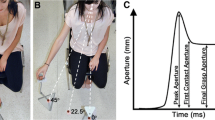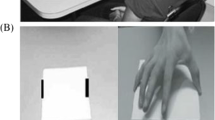Abstract
This study examined whether the pattern of coordination between arm-reaching toward an object (hand transport) and the initiation of aperture closure for grasping is different between PD patients and healthy individuals, and whether that pattern is affected by the necessity to quickly adjust the reach-to-grasp movement in response to an unexpected shift of target location. Subjects reached for and grasped a vertical dowel, the location of which was indicated by illuminating one of the three dowels placed on a horizontal plane. In control conditions, target location was fixed during the trial. In perturbation conditions, target location was shifted instantaneously by switching the illumination to a different dowel during the reach. The hand distance from the target at which the subject initiated aperture closure (aperture closure distance) was similar for both the control and perturbation conditions within each group of subjects. However, that distance was significantly closer to the target in the PD group than in the control group. The timing of aperture closure initiation varied considerably across the trials in both groups of subjects. In contrast, aperture closure distance was relatively invariant, suggesting that aperture closure initiation was determined by spatial parameters of arm kinematics rather than temporal parameters. The linear regression analysis of aperture closure distance showed that the distance was highly predictable based on the following three parameters: the amplitude of maximum grip aperture, hand velocity, and hand acceleration. This result implies that a control law, the arguments of which include the above parameters, governs the initiation of aperture closure. Further analysis revealed that the control law was very similar between the subject groups under each condition as well as between the control and perturbation conditions for each group. Consequently, the shorter aperture closure distance observed in PD patients apparently is a result of the hypometria of their grip aperture and bradykinesia of hand transport movement, rather than a consequence of a deficit in transport-grasp coordination. It is also concluded that the perturbation of target location does not disrupt the transport-grasp coordination in either healthy individuals or PD patients.



Similar content being viewed by others
References
Adamovich SV, Berkinblit MB, Hening W, Sage J, Poizner H (2001) The interaction of visual and proprioceptive inputs in pointing to actual and remembered targets in Parkinson’s disease. Neuroscience 104:1027–1041
Alberts JL, Tresilian JR, Stelmach GE (1998) The co-ordination and phasing of a bilateral prehension task The influence of Parkinson’s disease. Brain 121:725–742
Alberts JL, Saling M, Alder CH, Stelmach GE (2000) Disruptions in the reach-to-grasp actions of Parkinson’s patients. Exp Brain Res 134:353–362
Alberts JL, Saling M, Stelmach GE (2002) Alterations in transport path differentially affect temporal and spatial movement parameters. Exp Brain Res 143:417–425
Bennett KM, Marchetti M, Iovine R, Castiello U (1995) The drinking action of Parkinson’s disease subjects. Brain 118:959–970
Castiello U, Bennett KMB (1994) Parkinson’s disease: reorganization of the reach to grasp movement in response to perturbation of the distal motor patterning. Neuropsychologia 32:1367–1382
Castiello U, Bennett KMB, Alder CH, Stelmach GE (1993) Perturbation of the grasp component of a prehension movement in a subject with hemiParkinson’s disease. Neuropsychologia 31:717–723
Castiello U, Bennett K, Chambers H (1998) Reach to grasp: the response to a simultaneous perturbation of object position and size. Exp Brain Res 120:31–40
Castiello U, Bennett K, Bonfiglioli C, Lim S, Peppard RF (1999) The reach-to-grasp movement in Parkinson’s disease: response to a simultaneous perturbation of object position and object size. Exp Brain Res 125:453–462
Davis JH (2002) Foundations of deterministic and stochastic control. Birkhäuser, Boston
Debaere F, Wenderoth N, Sunaert S, Van Hecke P, Swinnen SP (2003) Internal versus external generation of movements: differential neural pathways involved in bimanual coordination performed in the presence or absence of augmented visual feedback. Neuroimage 19:764–776
Desmurget M, Prablanc C, Arzi M, Rossetti Y, Paulignan Y, Urquizar C (1996) Integrated control of hand transport and orientation during prehension movements. Exp Brain Res 110:265–278
Farley BG, Sherman S, Koshland GF (2004) Shoulder muscle activity in Parkinson’s disease during multijoint arm movements across a range of speeds. Exp Brain Res 154:160–175
Flament D, Vaillancourt DE, Kempf T, Shannon K, Corcos DM (2003) EMG remains fractionated in Parkinson’s disease, despite practice-related improvements in performance. Clin Neurophysiol 114:2385–2396
Folstein M, Folstein S, McHugh P (1975) “Mini-mental State” a practical method for grading the cognitive sate of patients for the clinician. J Psychiatr Res 12:189–198
Gentilucci M, Negrotti A (1999) The control of an action in Parkinson’s disease. Exp Brain Res 129:269–277
Gentilucci M, Chieffi S, Scarpa M, Castiello U (1992) Temporal coupling between transport and grasp components during prehension movements: effects of visual perturbation. Behav Brain Res 47:71–82
Haggard P, Wing A (1991) Remote responses to perturbation in human prehension. Neurosc Lett 122:103–108
Haggard P, Wing A (1995) Coordinated responses following mechanical perturbation of the arm during prehension. Exp Brain Res 102:483–494
Haggard P, Wing A (1998) Coordination of hand aperture with the spatial path of hand transport. Exp Brain Res 118:286–292
Hallett M, Khoshbin SA (1980) Physiological mechanism of bradykinesia. Brain 103:301–314
Hoff B, Arbib AM (1993) Models of trajectory formation and temporal interaction of reach and grasp. J Mot Behav 25:175–192
Jackson SR, Jackson GM, Harrison J, Kennard C (1995) The internal control of action and Parkinson’s disease: a kinematic analysis of visually guided and memory-guided prehension movements. Exp Brain Res 105:147–162
Jeannerod M (1981) Intersegmental coordination during reaching at natural visual objects. In: Long J, Baddeley A (eds) Attention and performance IX. Erlbaum, Hillsdale, pp 153–168
Jeannerod M (1984) The timing of natural prehension movements. J Mot Behav 16:235–254
Khudados E, Cody FW, O’Boyle DJ (1999) Proprioceptive regulation of voluntary ankle movements, demonstrated using muscle vibration, is impaired by Parkinson’s disease. J Neurol Neurosurg Psychiatry 67:504–510
Majsak MJ, Kaminski T, Gentile AM, Flanagan JR (1998) The reaching movements of patients with Parkinson’s disease under self-determined maximal speed and visually cues conditions. Brain 121:755–766
Marteniuk GG, Leavitt JL, MacKenzie CL, Athenes S (1990) Functional relationships between grasp and transport components in a prehension task. Hum Mov Sci 9:49–176
Morris ME, Iansek R, Matyas TA, Summers JJ (1996) Stride length regulation in Parkinson’s disease. Normalization strategies and underlying mechanisms. Brain 119:551–568
Oliveira RM, Gurd JM, Nixon P, Marshall JC, Passingham RE (1997) Micrographia in Parkinson’s disease: the effect of providing external cues. J Neurol Neurosurg Psychiatry 63:429–433
Paulignan Y, MacKenzie C, Marteniuk R, Jeannerod M (1991a) Selective perturbation of visual input during prehension movements: 1 The effects of changing object position. Exp Brain Res 83:502–512
Paulignan Y, MacKenzie C, Marteniuk R, Jeannerod M (1991b) Selective perturbation of visual input during prehension movements: 2 The effects of changing object size. Exp Brain Res 87:407–420
Plotnik M, Flash T, Inzelberg R, Schechtman E, Korczyn AD (1998) Motor switching abilities in Parkinson’s disease and old age: temporal aspects. J Neurol Neurosurg Psychiatry 65:328–337
Rand MK, Stelmach GE (2005) Effect of orienting the finger opposition space in the control of reach-to-grasp movements. J Mot Behav 37:65–78
Rand MK, Shimansky Y, Stelmach GE, Bracha V, Bloedel JR (2000) Effects of accuracy constraints on reach-to-grasp movements in cerebellar patients. Exp Brain Res 135:179–188
Rand MK, Shimansky Y, Stelmach GE, Bloedel JR (2004) Adaptation of reach-to-grasp movement in response to force perturbations. Exp Brain Res 154:50–65
Rickards C, Cody FW (1997) Proprioceptive control of wrist movements in Parkinson’s disease. Reduced muscle vibration-induced errors. Brain 120:977–990
Scarpa M, Castiello U (1994) Perturbation of prehension movement in Parkinson’s disease. Mov Disord 9:415–425
Schenk T, Baur B, Steude U, Botzel K (2003) Effects of deep brain stimulation on prehensile movements in PD patients are less pronounced when external timing cues are provided. Neuropsychologia 41:783–794
Schettino LF, Rajaraman V, Jack D, Adamovich SV, Sage J, Poizner H (2004) Deficits in the evolution of hand preshaping in Parkinson’s disease. Neuropsychologia 42:82–94
Seidler RD, Alberts JL, Stelmach GE (2001) Multijoint movement control in Parkinson’s disease. Exp Brain Res 140:335–344
Shimansky YP, Kang T, He J (2004) A novel model of motor learning capable of developing an optimal movement trajectory on-line from scratch. Biol Cybern 90:133–145
Squire LM, Rand MK, Stelmach GE (2004) Effect of speed manipulation in the control of aperture closure during reach-to-grasp movements. Soc Neurosci Abstr 30:653.3
Swinnen SP, Van Langendonk L, Verschueren S, Peeters G, Dom R, De Weerdt W (1997) Interlimb coordination deficits in patients with Parkinson’s disease during the production of two-joint oscillations in the sagittal plane. Mov Disord 12:958–968
Teasdale N, Bard C, Fleury M, Young D, Proteau L (1993) Determining movement onsets from temporal series. J Motor Behav 25:97–106
Tresilian JR, Stelmach GE, Adler CH (1997) Stability of reach-to-grasp movement patterns in Parkinson’s disease. Brain 120:2093–2111
Wallace SA, Weeks DL, Kelso JAS (1990) Temporal constraints in reaching and grasping behavior. Hum Mov Sci 9:69–93
Wang J, Stelmach GE (1998) Coordination among the body segments during reach-to-grasp action involving the trunk. Exp Brain Res 123:346–350
Wang J, Stelmach GE (2001) Spatial and temporal control of trunk-assisted prehensile actions. Exp Brain Res 136:231–240
Wang J, Stelmach GE (2000) Patients with Parkinson’s disease have motor synergy impairments in multijoint movements. Soc Neurosci Abstr 26:757
Wierzbicka MM, Wiegner AW, Logigian EL, Young RR (1991) Abnormal most-rapid isometric contractions in patients with Parkinson’s disease. J Neurol Neurosurg Psychiatry 54:210–216
Acknowledgements
This study was supported by NIH grants NS 36752 and NINDS NS 39352, NS 40266. We are grateful to Mr. Richard Bauer, Ms. Quinn Emerson and Ms. Linda M. Squire for their technical support. We also thank Dr. Todd Ajax and Dr. Michael Kitchell for their help with subject recruitment. Portions of the results of this study were presented at the Society for Neuroscience 34th Annual Meeting, San Diego, USA, 2004.
Author information
Authors and Affiliations
Corresponding author
Rights and permissions
About this article
Cite this article
Rand, M.K., Smiley-Oyen, A.L., Shimansky, Y.P. et al. Control of aperture closure during reach-to-grasp movements in parkinson’s disease. Exp Brain Res 168, 131–142 (2006). https://doi.org/10.1007/s00221-005-0073-3
Received:
Accepted:
Published:
Issue Date:
DOI: https://doi.org/10.1007/s00221-005-0073-3




